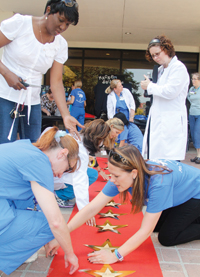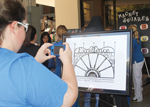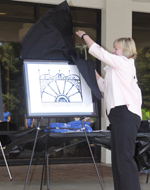|
by Cindy Abole
Public Relations
Nine months after MUSC nurses and
clinical staff formally committed
to achieving Magnet designation,
the group took the next step
toward excellence by defining and
unveiling the choice of a
professional nursing practice
model on Sept. 26 and Sept. 28.
 Medical center nurses
prepare the red carpet for the
nursing professional practice
model premier. Medical center nurses
prepare the red carpet for the
nursing professional practice
model premier.
MUSC's Professional Practice
Model, the Gate concept, was the
overall choice by nurses who
shared their thoughts in an April
survey conducted by the Magnet
Exemplary Professional Practice
Work Group. The Gate, one of two
concept entries, features a logo
of a Charleston ironwork gate that
focuses on nursing characteristics
identified by nurses, such as
collaboration, skillfulness,
advocacy, integrity, innovation
and accountability as its theme.
As achieving Magnet designation is
one of the seven driving
strategies of the MUSC Health
Strategic Plan, a Nursing
Professional Practice Model
schematically depicts how nurses
at MUSC deliver patient-centered
care.
The second entry, a Palmetto
tree, coordinates MUSC Excellence
characteristics featuring
professionalism, innovation,
compassion, evidence-based work
and skills. The Palmetto tree
model fits MUSC's culture,
resources and goals and defines
what is important to nurses and
what will drive the medical center's
current and future nursing
practice.
 Nurse Katie Steidle
takes a picture of the new Gate
concept selected by nurses
through an online survey. Nurse Katie Steidle
takes a picture of the new Gate
concept selected by nurses
through an online survey.
Marilyn Schaffner, Ph.D., R.N.,
administrator for clinical
services and chief nursing
executive, has been supportive of
MUSC's Magnet nursing process and
how it is elevating nursing
excellence. "Creating the MUSC
Nursing Professional Practice
Model solidifies our commitment to
nursing excellence and providing
quality care to our patients. As
we move forward on our Magnet
journey, I continue to be humbled
by the amazing work our nurses do
every day."
Dr.
Marilyn Schaffner unveiled
MUSC's first nursing
professional practice model
Sept. 26. 
Magnet nursing was established in
the 1990s through the American
Nurses Credentialing Center as a
way to recognize hospitals and
health care institutions that
offered excellent nursing care and
quality patient outcomes.
Achieving Magnet status is the
highest and most distinctive
recognition a health care
organization can receive for
nursing excellence and quality
outcomes.
Last August, nursing leadership
began taking steps toward Magnet
designation. On Jan. 18, MUSC
nurses, with support from hospital
leadership, kicked off the
journey.
The Magnet nursing model
identifies five concepts:
transformational leadership,
structural empowerment, exemplary
professional practice, new
knowledge, innovations and
improvements and empirical
outcomes. Throughout this process,
nurses are embracing the
opportunity to serve in each of
these areas to develop or revise
standards and policies,
collaborate with other
professionals, focus on continuing
education and improve the overall
nursing environment.
Members of the Magnet Exemplary
Professional Practice work group
began efforts to identify and
create a nursing professional
practice model to describe nursing
practices. To initiate the
process, the group polled nurses
with an online survey asking for
their input about nursing and
nursing practices. They compiled
the results and converted their
findings to qualitative data for
further analysis. From there, they
identified key attributes that
connected with nurses and their
profession. One common theme
identified was "caring" as a
central focus. They also embraced
author Jean Watson's theory of
human caring as central to their
Professional Nursing Practice
model concepts. Watson describes
caring as the most valuable
attribute nursing offers to
humanity and to patient care. The
team also evaluated the role of
nurses with patients, families,
their communities as well as their
relationships with colleagues and
patient outcomes.
Darcy Kalles, R.N., Heart &
Vascular Center administration
director, who co-chaired the work
group with Cameron Mitchum, R.N.,
STICU nurse educator, was excited
about the team's progress in just
five months. The team worked
separately in two subgroups for
six weeks to establish and confirm
the nursing models.
"Our group was dedicated to
finding a nursing practice model
that honestly describes nursing at
MUSC that everyone could embrace,"
Kalles said.
Dorothy Whisenhunt, R.N., 9East,
was excited to see the hospital's
progress in the Magnet journey and
glad to share her input about
nursing and providing patient
care. "I am thrilled that we, as
nurses at MUSC, are able to create
a nursing practice model based on
our own priorities and beliefs.
Building and voting on our own
nursing practice model makes the
entire Magnet journey more
personal and unique for each and
every nurse. The new practice
model gives more meaning to what
we do for our patients every day."
To help visualize each model's
key concepts, the team
collaborated with University
Press' graphic design staff to
translate the two concept ideas
into a graphic image that
communicated nursing keys and were
identifiable with Charleston's
Lowcountry.
By mid-summer, the team unveiled
the two model concepts, the Gate
and the Palmetto tree. All nurses
had the opportunity to vote on the
model each person believed to best
represent MUSC nursing. More than
955 nurses participated in the
online voting and official results
of the winning professional
nursing practice plan were
unveiled at the Sept. 26 red
carpet premiere. On Sept. 26 and
Sept. 28 the winning model was
displayed at the Ashley River
Tower mezzanine and the Rutledge
Tower walkway.
Next, Kalles and her team will
work with the Magnet
Communications Committee to
promote this new model to all
nurses and medical center staff.
"We want our nurses to not only
understand it, but also share it
with others about the joy of
nursing and how we impact patient
care."
Exemplary Professional
Practice Workgroup
Cameron Mitchum, R.N., and Darcy
Kalles, R.N., co-chairs; Ramita
Bonadonna, Ph.D., R.N.,
Psychiatry; Weatherly Brice R.N.,
Women's Health; Natalie Emanuel,
R.N., 7East Pediatrics; Jennette
Freund, R.N., Adult Cath Lab; Sara
Gayle McConnell, RNC, Neonatal
Nurseries; Abigail Powers, R.N., 3
West, ART; Michelle Sharp, RNC,
Women's Health; Katie Steidle,
R.N., 8 East, and Kathleen White,
R.N., Neonatal Intensive Care
|



 Medical center nurses
prepare the red carpet for the
nursing professional practice
model premier.
Medical center nurses
prepare the red carpet for the
nursing professional practice
model premier.  Nurse Katie Steidle
takes a picture of the new Gate
concept selected by nurses
through an online survey.
Nurse Katie Steidle
takes a picture of the new Gate
concept selected by nurses
through an online survey.